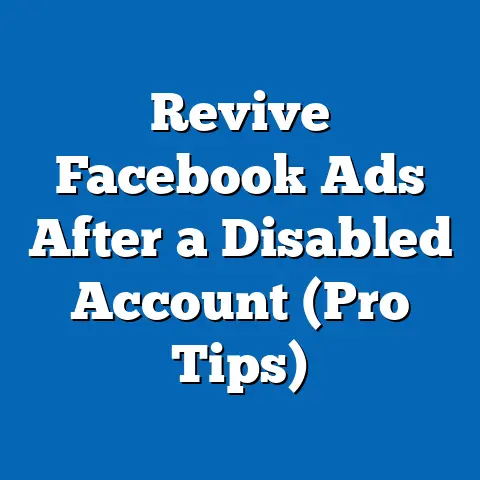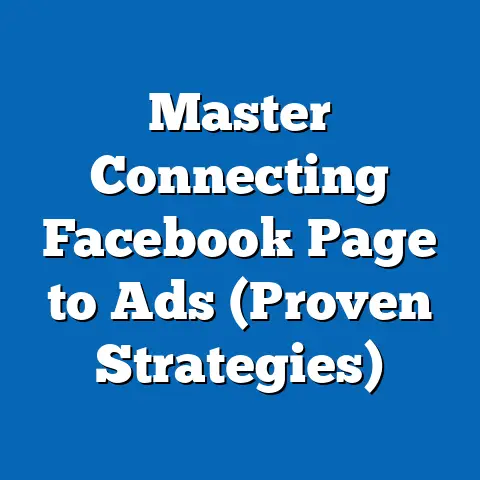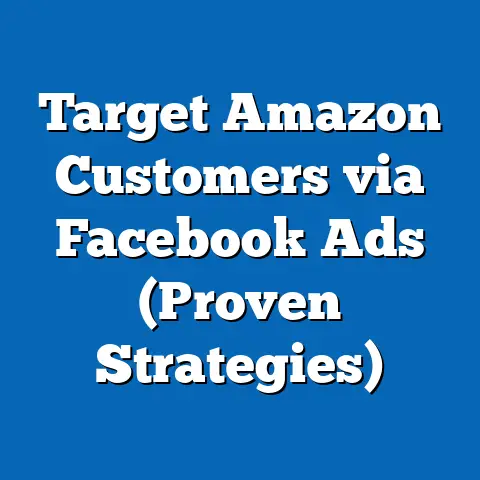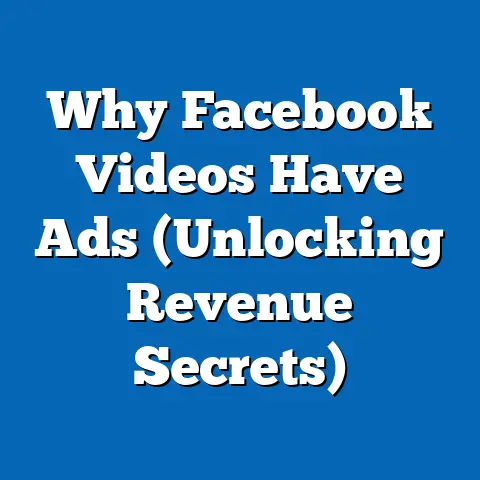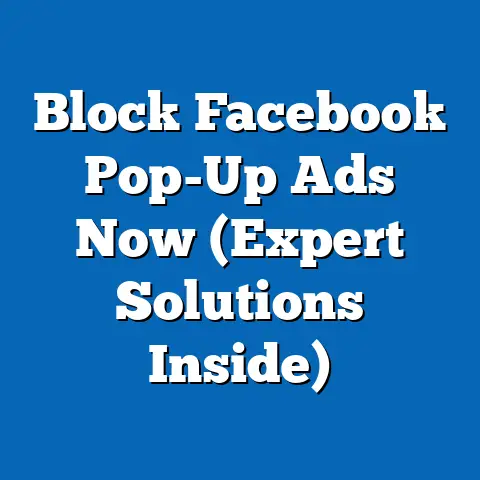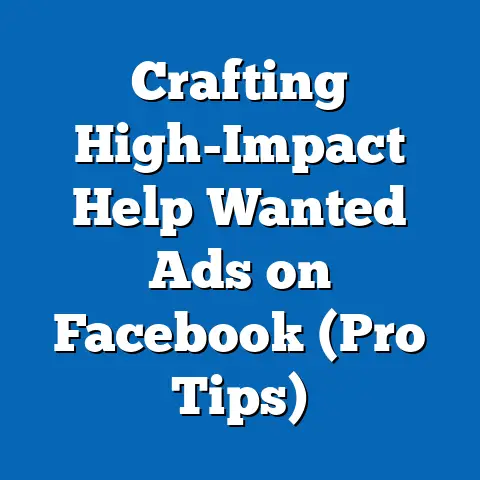Boost fb ad Engagement with Direct Messaging (Pro Tips Inside)
It’s almost comical, isn’t it? In a world where businesses pour thousands into creating the perfect Facebook ad, meticulously crafting every pixel and word, it’s easy to overlook the personal touch that direct messaging can provide. Who would have thought that a few heartfelt words, a personalized response, or even a well-placed emoji could outperform high-budget video ads? Yet, that little message icon sitting innocently on your Facebook Page could be the secret sauce you’ve been missing.
I’ve seen it firsthand. I’ve watched businesses, frustrated by lackluster engagement on their visually stunning ads, completely transform their results by simply starting conversations. It’s like finally finding the missing piece of the puzzle.
Introduction
Facebook advertising remains a cornerstone of digital marketing for businesses of all sizes. With billions of active users, the platform offers unparalleled reach and targeting capabilities. However, in today’s competitive landscape, simply running ads isn’t enough. Businesses need to find innovative ways to cut through the noise and truly engage their audience. That’s where direct messaging comes in.
While many focus solely on optimizing ad creative and targeting, I believe that leveraging direct messaging is a powerful tool often overlooked. It’s about going beyond the click and building genuine connections with potential customers. This article will explore how to integrate direct messaging into your Facebook ad campaigns to boost engagement, drive conversions, and foster lasting customer relationships.
Understanding the Power of Direct Messaging
Direct messaging is more than just a way to answer customer inquiries. It’s a dynamic channel for building relationships, providing personalized support, and driving conversions. Unlike traditional ad engagement, which often involves passive actions like liking or sharing, direct messaging fosters active interaction and dialogue.
Think about it: when someone sends your business a direct message, they’re initiating a conversation. They’re showing a level of interest that goes beyond simply browsing. This presents a golden opportunity to connect with them on a personal level, address their specific needs, and guide them towards a purchase.
Why is it so effective?
- Personalization: Direct messaging allows for tailored communication based on individual user interactions. You can address specific questions, offer personalized recommendations, and create a truly unique experience.
- Immediacy: In today’s fast-paced world, people expect instant gratification. Direct messaging provides a quick and convenient way for customers to get their questions answered and resolve their issues.
- Trust and Connection: Personal communication fosters a sense of connection and trust. When customers feel like they’re talking to a real person who cares about their needs, they’re more likely to engage with your brand.
- Reduced Friction: Instead of navigating a website or filling out a form, customers can simply send a message and get the information they need. This reduces friction and makes it easier for them to convert.
According to a recent study by Facebook, businesses that use messaging for customer service see a 20% higher customer satisfaction rate than those that don’t. Furthermore, a report by Twilio found that 90% of consumers want to use messaging to communicate with businesses. These statistics highlight the growing importance of direct messaging in today’s digital landscape.
I remember working with a local bakery that was struggling to gain traction on Facebook. Their ads were beautiful, showcasing their delicious pastries, but engagement was low. We decided to incorporate a direct messaging strategy, encouraging users to message them with questions about custom cake orders. Suddenly, their inbox exploded with inquiries. They were able to connect with potential customers on a personal level, discuss their specific needs, and ultimately, book more orders. It was a game-changer for their business.
Key Takeaway: Direct messaging offers a powerful way to personalize communication, build trust, and reduce friction in the customer journey. It’s not just about answering questions; it’s about building relationships.
Creating a Seamless Link Between Ads and Messaging
Integrating direct messaging into your Facebook ad campaigns requires a strategic approach. It’s not enough to simply add a “Message Us” button to your ads. You need to create a compelling reason for users to engage via direct message and ensure a seamless transition from the ad to the messaging experience.
Here’s how to do it:
- Choose the Right Ad Objective: When creating your ad, select the “Messages” objective. This will optimize your ad delivery to reach people who are most likely to send you a message.
- Craft Compelling Ad Copy: Your ad copy should clearly communicate the benefits of messaging your business. Highlight the value proposition and encourage users to take action. For example:
- “Have questions about our latest collection? Message us now for personalized styling advice!”
- “Get a free quote for your custom project! Send us a message with your requirements.”
- “Unlock exclusive discounts and promotions! Message us ‘UNLOCK’ to get started.”
- Use Engaging Visuals: Your ad visuals should be eye-catching and relevant to your offer. Consider using images or videos that showcase your product or service in action. You can even incorporate text overlays that encourage users to message you.
- Implement Clear Calls-to-Action (CTAs): Your CTA should be clear, concise, and action-oriented. Use phrases like “Message Us,” “Send Message,” “Learn More & Message,” or “Get Started Now.”
- Set Up Automated Responses: Use Facebook’s automated response features to instantly acknowledge new messages and provide basic information. This ensures that users receive a prompt response, even when you’re not immediately available.
- Use Click-to-Messenger Ads: Click-to-Messenger ads allow users to start a conversation with your business directly from the ad. When a user clicks on the ad, they’re automatically redirected to Messenger, where they can begin a conversation.
- “Have questions about our latest collection? Message us now for personalized styling advice!”
- “Get a free quote for your custom project! Send us a message with your requirements.”
- “Unlock exclusive discounts and promotions! Message us ‘UNLOCK’ to get started.”
I always recommend testing different ad copy, visuals, and CTAs to see what resonates best with your audience. A/B testing is your best friend when it comes to optimizing your ad performance.
Example:
Imagine you’re running an ad for a new online course. Instead of simply promoting the course features, you could create an ad that encourages users to message you with their specific learning goals. The ad copy could read: “Ready to level up your skills? Message us with your biggest learning challenge, and we’ll help you find the perfect course for your needs!”
This approach not only drives engagement but also allows you to gather valuable insights into your audience’s needs and preferences.
Key Takeaway: Create a seamless experience by choosing the right ad objective, crafting compelling ad copy and visuals, implementing clear CTAs, and setting up automated responses. Make it easy and appealing for users to engage with your business via direct message.
Pro Tips for Boosting Engagement through Direct Messaging
Once you’ve integrated direct messaging into your Facebook ad campaigns, the real work begins. To truly maximize engagement, you need to go beyond simply answering questions and start creating meaningful interactions. Here are some pro tips to help you boost engagement through direct messaging:
Tip 1: Personalization
Generic responses are a surefire way to turn off potential customers. Instead, take the time to personalize your messages based on individual user interactions.
- Use their name: Address users by their first name whenever possible.
- Reference their previous interactions: If a user has interacted with your business before, acknowledge their previous engagement.
- Tailor your responses: Answer their specific questions and address their individual needs.
- Offer personalized recommendations: Suggest products or services that align with their interests and preferences.
I once helped a clothing boutique personalize their direct messaging strategy. Instead of sending generic product recommendations, they started asking users about their personal style and preferences. They then used this information to curate personalized outfit recommendations, which resulted in a significant increase in sales.
Tip 2: Timeliness
Responsiveness is crucial in today’s fast-paced world. The quicker you respond to inquiries, the more likely you are to capture the user’s attention and drive engagement.
- Set up automated responses: Use Facebook’s automated response features to instantly acknowledge new messages and provide basic information.
- Monitor your inbox regularly: Check your inbox frequently and respond to messages as quickly as possible.
- Set expectations: If you’re unable to respond immediately, let users know when they can expect a response.
- Use a chatbot: Consider using a chatbot to handle common inquiries and provide instant support.
I recommend aiming for a response time of under 5 minutes. Even a brief acknowledgement that you’ve received their message can make a big difference.
Tip 3: Interactive Elements
Incorporating interactive elements into your messages can significantly enhance user interaction and keep them engaged.
- Quizzes: Create fun and engaging quizzes that relate to your brand or industry.
- Polls: Ask users for their opinions on relevant topics.
- User-generated content: Encourage users to share their photos or videos related to your brand.
- Games: Incorporate simple games or puzzles into your messages.
A local coffee shop used a poll in their direct messages asking users to vote for their favorite seasonal drink. This not only generated engagement but also provided valuable insights into customer preferences.
Tip 4: Customer Support
Direct messaging is an excellent channel for providing customer support. By offering quick and convenient support, you can improve brand loyalty and encourage engagement.
- Answer customer inquiries: Address customer questions and concerns promptly and professionally.
- Resolve issues: Help customers resolve any issues they may be experiencing with your products or services.
- Provide helpful resources: Share links to relevant articles, FAQs, or tutorials.
- Offer personalized assistance: Go the extra mile to provide personalized support and guidance.
I’ve seen businesses transform negative experiences into positive ones by providing exceptional customer support through direct messaging. A quick and helpful response can often turn a disgruntled customer into a loyal advocate.
Tip 5: Exclusive Offers
Sending exclusive promotions or discounts via direct messaging is a great way to incentivize engagement and drive sales.
- Offer exclusive discounts: Provide users with a special discount code that they can use on their next purchase.
- Run limited-time promotions: Create a sense of urgency by offering exclusive promotions that are only available for a limited time.
- Reward loyal customers: Send exclusive offers to your most loyal customers as a thank you for their support.
- Offer freebies or samples: Give away freebies or samples to incentivize engagement.
A fitness studio offered a free week of classes to anyone who messaged them “FITNESS.” This simple promotion generated a huge influx of messages and resulted in a significant increase in new memberships.
Key Takeaway: Personalize your messages, respond quickly, incorporate interactive elements, provide excellent customer support, and offer exclusive promotions to maximize engagement through direct messaging.
Case Studies and Success Stories
Numerous brands have successfully utilized direct messaging to enhance their Facebook ad engagement. Here are a few real-life examples:
- Sephora: The beauty retailer uses Messenger to offer personalized beauty advice and product recommendations. Customers can message Sephora with their skin concerns or makeup questions, and a beauty expert will provide tailored recommendations. This personalized approach has resulted in a significant increase in sales and customer loyalty.
- Domino’s: The pizza chain allows customers to order pizza directly through Messenger. Customers can simply message Domino’s with their order, and the chatbot will guide them through the ordering process. This convenient and efficient ordering experience has made Domino’s a leader in the pizza delivery industry.
- KLM Royal Dutch Airlines: The airline uses Messenger to provide customers with flight updates, boarding passes, and baggage information. Customers can message KLM with their flight number, and the chatbot will provide them with real-time updates. This proactive approach has improved customer satisfaction and reduced the number of customer service inquiries.
I personally worked with a local bookstore that implemented a direct messaging strategy to promote their book club. They created an ad that encouraged users to message them to learn more about the book club and sign up. They then used Messenger to send users updates about upcoming meetings, book recommendations, and exclusive discounts. This strategy not only increased book club membership but also fostered a strong sense of community among members.
Key Takeaway: These case studies demonstrate the versatility and effectiveness of direct messaging as a tool for enhancing Facebook ad engagement. By providing personalized support, streamlining processes, and fostering a sense of community, businesses can leverage direct messaging to achieve significant results.
Tools and Platforms for Effective Messaging
Managing direct messaging efforts on Facebook can be challenging, especially for businesses with a large volume of inquiries. Fortunately, several tools and platforms can help streamline communication and improve response times.
- Facebook Page Inbox: Facebook’s built-in Page Inbox allows you to manage all your messages in one place. You can filter messages, assign them to different team members, and create automated responses.
- Chatbots: Chatbots are automated messaging tools that can handle common inquiries and provide instant support. They can be programmed to answer frequently asked questions, provide product information, and even process orders. Popular chatbot platforms include ManyChat, Chatfuel, and MobileMonkey.
- CRM Systems: Customer Relationship Management (CRM) systems can help you track customer interactions and personalize your messaging efforts. By integrating your CRM with Facebook Messenger, you can access customer data and tailor your responses accordingly. Popular CRM systems include HubSpot, Salesforce, and Zoho CRM.
- Third-Party Messaging Platforms: Several third-party messaging platforms offer advanced features for managing Facebook Messenger conversations. These platforms often include features like live chat, team collaboration, and analytics. Popular messaging platforms include Zendesk, Intercom, and Freshdesk.
I always advise businesses to carefully evaluate their needs and choose the tools and platforms that best align with their goals. A well-chosen tool can significantly improve efficiency and enhance the overall customer experience.
Key Takeaway: Utilize tools and platforms like Facebook Page Inbox, chatbots, CRM systems, and third-party messaging platforms to streamline communication, improve response times, and personalize your messaging efforts.
Conclusion
In conclusion, integrating direct messaging into your Facebook ad strategies is no longer a luxury but a necessity. It’s a powerful tool for building relationships, providing personalized support, and driving conversions. By crafting compelling ad copy, implementing clear CTAs, personalizing your messages, and utilizing the right tools and platforms, you can unlock the full potential of direct messaging and achieve significant results.
As the digital landscape continues to evolve, the importance of personal connection will only continue to grow. In a world saturated with ads and marketing messages, the ability to connect with customers on a personal level will be the key to standing out from the crowd. Are you ready to embrace the power of direct messaging and transform your Facebook ad engagement?
Call to Action
I encourage you to implement these strategies in your own campaigns and share your experiences in the comments below. I’m eager to hear about your successes and challenges. And if you have any questions, feel free to send me a direct message on Facebook! Let’s connect and learn from each other.

